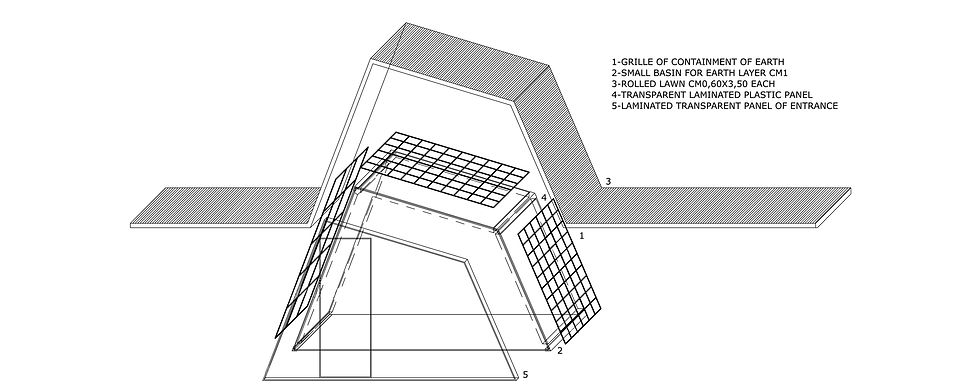
11.0 m2
As I walk down the main road through the city, my gaze falls on my footsteps: I realise I am not leaving any footprints. There is no longer any direct contact with the earth, covered by a gigantic slab of asphalt.
I notice the same separation between people, walking like me through the town centre. It is as though we are in an infinite network, the chains of which put us into communication only for the time it takes to pass by. Everything is reduced to goods, consumption, opportunities of investment and profit. I see the earth I would like to tread has been completely replaced. My search becomes frenetic, like a wayfarer I go in search of untraced itineraries; I look everywhere for signs that will bring me back to a lost relationship, between man and nature, between man and his freedom.
After long hours of walking, I am unable despite all my efforts to find even the tiniest fragment of earth. By now I am desperate and I see in the shop window of a large supermarket something which resembles the object of my search. I go inside. On the shelves there are DIY kits to construct tiny homes, simulating mountains, hills, plains, deserts, rocks and meadows. I can’t believe my eyes, the material is authentic, I take a box of meadow and quickly return home. Once outside, I make my way to an empty space, open the kit and begin to assemble it. The architecture begins to take shape, producing a liberating effect which coincides at that moment with my practice of freedom.
Freely adapted from Michel Foucault Biopolitics and liberalism
Edizioni Medusa- Milan
The temporary, biocompatible house features a system of 1.2 mm-thick, polycarbonate, honeycomb panels resting on an interlocking, tubular steel structure. The honeycomb surface is made like a tray, so that a grid can hold a very fine, 3 cm layer of earth in place on the honeycomb panel. The end result is placed on the lawn and divided into 60 cm strips. Once the lawn is placed over the house like a cape, it is regularly watered via an automatic system.
The trapezoidal shape (or the shape of a traditional house), created to resolve a technological problem and to allow the water to flow away correctly, is simple and so elementary as to become integrated with the surrounding context. The layer of earth and the lawn represent an excellent system of insulation against heat, as actually occurs in the Mediterranean tradition. In this specific case, we are speaking of a mobile, flexible house, featuring modules which can be assembled in different ways and sizes. The structural steel modules feature an interlocking system. The infill panels are 1.6mm thick and measure 3m wide by 2.5m high by 1.2m deep (on which two strips of lawn will be placed), and enable a door and a window to be cut out in the polycarbonate, honeycomb surface as required.
Lastly, some mono and/or polycrystalline, amorphous silicon, photovoltaic modules are placed on top of the structure. The latter are also cut in small, 20 cm-wide strips, whereas the length matches that of the structure. The modules can be positioned using opportune locking systems on any part of the surface, with the sole restriction that it must always face south according to requirements. The position of the storage batteries will be reviewed each time to predict the expedients required to optimise the production of electricity.
Project: altro_studio
Anna Rita Emili-Architect
Consultant:
Aldo Innocenzi Artist
Collaborators:
FilippoCamilli
Photo:
Emanuele Piccardo
Giovanna
Contractor:
Vivai Bindi Rome-rolled lawn
Fedeli Laminate plastic panels









